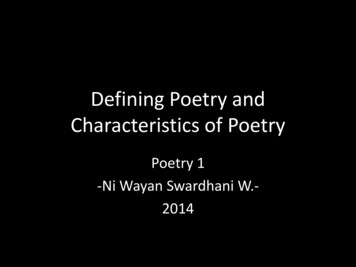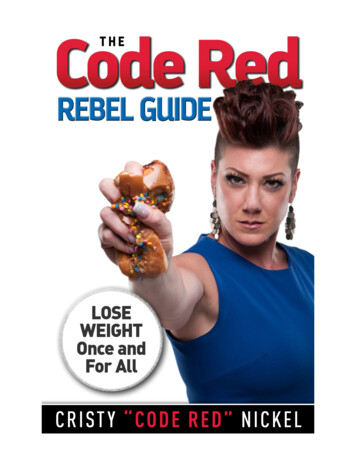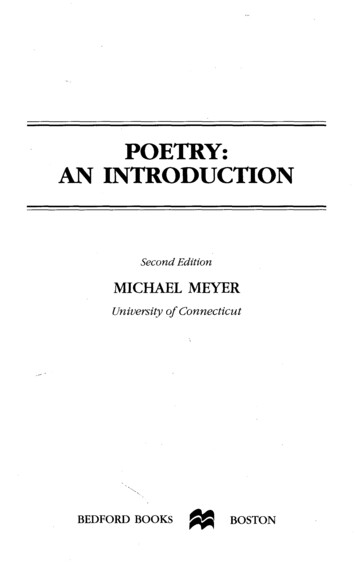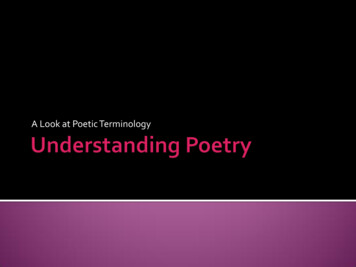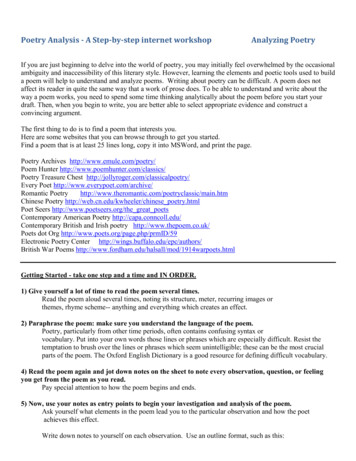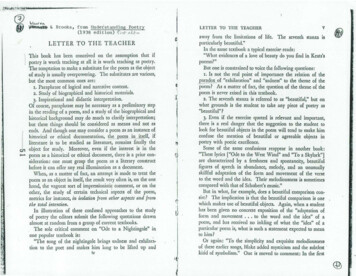
Transcription
PoetryWhat is it?What is it not?(Prose)
1st Rule of Poetry:Rules can be broken,within reasonJust as James Bond has alicense to kill, poets havePoetic License
Elements: Speaker The speaker is the voice orpersona of the poem. It is not necessarily alwaysthe poet. Sometimes the poet createsa speaker that is non-humanor even an inanimate object.
Elements: ToneTone is the attitude,expressed through thelanguage, that thespeaker has towardhis/her/its subject
2nd Rule of PoetryPoetry is read aloud much likeprose:– Major pauses occur at punctuation andbetween clauses– Simply because a line ends, doesn’tmean there is a pause
Basic Poem Types Narrative- Tells a story* (in past tense)– Ballad: involves folk hero– Epic: involves larger-than life heroes Dramatic- A story*-in-progress– Monologue: letter, or prayer– Dialogue: conversation Lyric- deals with a subject (love, nature,death) but does not have plot*Remember the basic elements of a story!!!
3rd Rule of PoetryPoetry must follow the rules of syntax(word ordering system; see grammarsection of notes):Sentences, like cars, are constructedof parts, each part having a function.If you threw together a car with randomlyselected parts into randomly selectedpositions, would it run?
Why is syntax so important?Car blue thesquashed falling waspiano a by.
Parts of Speech in English Noun person, place ,thing, idea:– John, Nevada, universe, book, love Verb action or state of being:– climb, swim, jump, is, flying, writing– Infinitive verbs: to climb, to swim– a gerund is a verb acting as a noun:I like climbing. Swimming is fun. Auxiliary Verbs helping verbs:– is- , was- , am-, have/has been-, will-
Parts of Speech in English Adjective describes noun:– red, large, shallow, round Adverb describes verb or adjective:– slowly, quickly, then Pronoun substitute noun:– he, she, them, it, who, whom, which, that
Parts of Speech in English Preposition denotes location, time,relationship: --on, above, beforefor, of, to Conjunction connects words, phrases,clauses: --if, and, but, than Interjection conveys emotion:--Wow! Hooray! Articles introduce nouns: --the, a
Syntax- Sentence ComponentsAll sentences must have a subject and apredicate:The cacophony of clattering cups in the kitchenwas caused by Karen.Sometimes the subject is implied:(you) Get out of here!
Syntax- Sentence ComponentsClauses: Segments of sentences that contain both a subject and apredicate.Independent Clauses and Dependent Clauses:– After she eats, she does the dishes.– She didn’t see the person who broke her doll.– Chewing with her mouth open is the reason why Fred cannot stand sittingacross from his sister Melanie.– She cried a little because she wanted a new one.Independent Clauses are joined by coordinating conjunctions like because,although, since, even though, and standard conjunctions and, but, for, or
Syntax- Sentence ComponentsPhrases:Segments of sentences that are missing eithera subject or a predicate, or both.Noun Phrase: My coach is happy .Verb Phrase: The team is in the middle of playing a game.Adjective Phrase: It was a very close and exciting game.Adverbial Phrase: I scored the goal very quickly.Prepositional Phrase: Dad was happy about the goal.
Phrases and ClausesThe bear attacked as he was walkingthrough the woods.(Dependent clause following independent clause)The well kept house nevertheless failsto sell in the current economy.(noun phrase; verb phrase; prepositional phrase)
Parts of Speech &Sentence ComponentsA delicately arranged bouquetof flowers welcomed visitorsto the front desk, but theclerk, who was allergic,detested it.
4th Rule of PoetryPoems effectively use wordsto convey meaning-What’s a poem withoutwords?-
RhetoricThe use of language (words)to convey meaning, ideas,prove a point, make a case,etc.
Rhetorical FiguresSimile- a direct comparison, usinglinking words such as like, as, than– Right as rain; older than sinPersonification- giving humancharacteristics to the non-human.– Fear came knocking at the door
Rhetorical FiguresMetaphor- a comparison betweentwo vastly different things, thathave a commonality that is thefocus of the comparison– Her courage was a rock duringthat difficult time
Rhetorical Figures- metaphors Extended metaphor- carried through many lines– All the world's a stage,And all the men and women merely players;They have their exits and their entrances,And one man in his time plays many parts,His acts being seven ages.(Shakespeare’s As You Like It) Implied metaphor- comparison is subtle– Moriarty slithered away from the crime scene Synesthetic cross-sensory metaphorLoud colors; sweet-smelling; light musicX c Synecdoche- one part standing for the whole– I like your wheels, man! [wheels car] or All hands on deck! [hands sailors] Metonymy- the whole standing for a part– the White House has no comment on that
Rhetoric:Imagery Imagery is the use of sensoryinformation in the poem. Imagery puts the reader inthe poem. It helps the readerto “experience” the poem.
ImagerySensory details draw upon the senses: Sight: visual imagery Sound: auditory imagery Taste: gustatory imagery Smell: olfactory imagery Touch: tactile imagery c
ImageryDon’t forget the other senses!!! Organic imagery: Internal, whichincludes pain, thirst, fatigue Kinesthetic imagery:Vestibularand proprioceptive senses, includingbalance, acceleration, and equilibrium
Rhetoric: Diction DENOTATION- the dictionarydefinition of a word CONNOTATION- the impliedmeaning, the feeling orimpression associated with aword
Rhetoric:ConnotationEloise’s new outfit clearlyexposes her skinny frame.Eloise’s new outfit clearlyexhibits her slender frame.
5th Rule of PoetryPoems effectively use soundto convey meaningPoetry is not a silent art form!!!
Sound has nothing to do with spelling!English Alphabet (26 letters) :ABCDEFGHIJKLMNOPQRSTUVWXYZEnglishPhonemes(44 total):
Sound Devices Alliteration - repetitive initialphonemes in words of a line ofpoetry Consonance - repetition ofconsonant phonemes anywherein a line of poetry Assonance - repetitive vowelphonemes
Sound DevicesOnomatopoeia – use ofwords that make thesound they arerepresenting.Pop, crash, bang, slap
Onomatopoeia by Eve MerriamThe rusty spigotsputter,uttersa sputter,spatters asmattering of drops,splatters,scatters,spurts,finally stops sputteringand plash!gashes wider;gushes rushes splashesslash,clear water dashes.
Sound Devices Poems also create musicthrough the repetition ofwords and lines. Refrain- the repetition of a line Chorus- the repetition ofseveral lines of poetry
RhymeExact rhyme are words that havethe exact same-soundingending, like cat and hatSlant rhyme words sound similar,but aren’t exact, like one anddown or seen and neat
Sound- Rhyme Internal Rhyme- rhymingwords within a line End rhyme - rhyming words atends of lines Couplet- 2 consecutive lines withthe same end rhyme
Rhyme Scheme- the pattern ofend rhyme, denoted using letters ABCD etc.Look for other sound devices used here.The splendor falls on castle wallsAAnd snowy summits old in story;BThe long light shakes across the lakes,CAnd the wild cataract leaps in glory.BBlow, bugle, blow, set the wild echoes flying,DBlow, bugle; answer, echoes, dying, dying, dying. D
SoundRhythm: the pattern of stressedand unstressed syllables in aline, marked by feet.Meter: the number of feet in aline.(the measurement of poetry)
Metrical Feet in Poetryiamb2trochee2anapest 3dactyl3spondee 2pyrrhic2Second syllable isstressedFirst syllable isstressedThird syllable isstressedFirst syllable isstressedTwo consecutivestressed syllablesTwo consecutiveunstressedsyllablesu goodbye uawfulu u Halloween u uwonderful big dealu u(no such wordin English)
Feet per line in poetry scansion:Monometer 1Pentameter * 5Dimeter2HexameterTrimeter *3Heptameter 7Tetrameter * 4Octameter* Common to poetry written in English.68
SoundScansion: describing the rhythms of poetryby marking (see examples) the locations of– stressed ( ) andFinding the rhythm– unstressed ( U ) syllables,– dividing the lines into feet ( I ) andMeasuring the rhythm– counting the feet.The entire process is called scanning a poem.
SoundCaesuraA pause within a line of poetry ;contributes to the rhythm of theline. Marked in scansion by
From Julius CaesarIt must be by his death and for my partI know no personal cause to spurn at himBut for the general. He would be crowned.
From Julius Caesar/UU//U/U/UIt must be by his death and for my part/UU/U/U/U/I know no personal cause to spurn at him//U/UUU/U/But for the general. He would be crowned.
6th Rule of PoetryPoems have some semblanceof form.Poems follow rhyme, rhythm, or linegrouping patternsBut remember Rule #1:Fixed Form versus Free Verse
StructurePatterns in poetrythat give a poemits form.
StructureStanza – grouping oflines in poetry A stanza in poetry is like aparagraph in prose.
Structure in Poetry Couplet- 2 consecutive lineswith the same end rhyme Tercet- 3 line pattern Quatrain- 4 line pattern Quintet- 5 line pattern Sestet- 6 line pattern Septet- 7 line pattern Octave- 8 line pattern
Fixed Forms Poems are categorized by thepattern of its lines, meter,rhythm, or stanzas Fixed form poems may not alwaysfit into categories precisely,because poets sometimes varytraditional forms to createinnovative effects
Fixed Forms Sonnet – “Little Song”Sonnets propose a situation, attitude, orproblem that is resolved at the volta–Italian (Petrarchan) abbaabba then cdecde or cdcdcd or cdccdc–English-always end with a couplet Elizabethan- abab cdcd efef gg Spenserian- abab bcbc cdcd ee
Fixed Forms Sestina- 6 sestets 1 tercet;six keywords repeated at ends oflines and twice in each line of tercet Villanelle- 5 tercets 1 quatrain;line 1 refrained at lines 6, 12, 18;line 3 refrained at lines 9, 15, 19 Limerick- light subjects; aabba;lines 1,2,5 3 feet; 3,4 2 feet1 iamb 2 anapests; 1 iamb, 1 anapest
LimerickThere was an old person of CromerWho stood on one leg to read Homer.When he found he grew stiffHe jumped over the cliff,Which concluded that person of Cromer.
7th Rule of PoetryPoetry must have somemessage that is universallyapplicable (THEME)Otherwise, why would it appeal to othersbesides the poet?
PoetryExplicationA piece ofwriting thatexplains indetail theintricacies ofa poemBasic Requirementsfor discussion: THEME Situation, Speaker& Tone Structure & Form Sound: rhythm & devices Rhetoric: diction & devices
SilverSlowly, silently, now the moonWalks the night in her silver shoon;This way and that, she peers, and seesSilver fruit upon silver trees;One by one the casements catchHer beams beneath the silvery thatch;Couched in his kennel, like a log,With paws of silver sleeps the dog;From their shadowy coat the white breasts peepOf doves in a silver-feathered sleep;A harvest mouse goes scampering by,With silver claws, and silver eye;And moveless fish in the water gleam,By silver reeds in a silver stream.—Walter de la Mare
Sample Explication bitRepetition:“silver”Alliteration:“silver hoon”In the poem “Silver,” Walter de la Mare uses repetition,alliteration, onomatopoeia, and assonance to create a particularmood. By repeating the word “silver”, the poet emphasizes thesubject of the poem: the moon’s silvery light. Similarly, thealliteration “silver shoon” (2) creates a “shh” sound thatimitates the silence described in the poem in which even thedove’s “peep” (9) can be heard. Finally, the assonance inrhymes like “moon” and “shoon” seems to echo the figure ofthe moon itself, as your mouth must make the shape of an “O”in order to create those sounds.
FogThe fog comeson little cat feet.It sits lookingover harbor and cityon silent haunchesand then moves on.—Carl Sandburg
Sample Explication bitMetaphor:The fog is compared to a cat.In the poem “Fog,” Carl Sandburg uses a metaphor todescribe the mysterious movement of fog. By comparing the fogto a cat, Sandburg suggests that fog moves quietly and stealthily,as he creates the visual image of fog “on silent haunches” (5)looking out over the harbor.
Autumn Chant- Edna St. Vincent MillayNow the autumn shuddersIn the rose's root.Far and wide the laddersLean among the fruit.Now the autumn clambersUp the trellised frame,And the rose remembersThe dust from which it came.Brighter than the blossomOn the rose's boughSits the wizened orange,Bitter berry now;Beauty never slumbers;All is in her name;But the rose remembersThe dust from which it came
Sample Explication bitStanzas: 4Lines/: 4Scheme: ABAB (ABCB lines 9-12)Rhythm : trochaic trimeterMillay’s poem consists of four four-line stanzas. Forthe most part the rhyme scheme consists of alternating endrhyme; that is, ABAB. A deviation occurs in the third stanza,which is known as a ballad stanza due to its rhyme scheme ofABCB. The rhythm is trochaic trimeter, except that in thesecond and fourth lines of each stanza the final unstressedsyllable is dropped. This variance adds additional rhythmfrom line to line.
Adjective Phrase: It was a very close and exciting game. Adverbial Phrase: I scored the goal very quickly. Prepositional Phrase: Dad was happy about the goal. Phrases and Clauses The bear attacked as he was walking through the woods. (Dependent clause following independent clause) The well kept house nevertheless fails to sell in the current economy. (noun phrase; verb phrase; prepositional .
